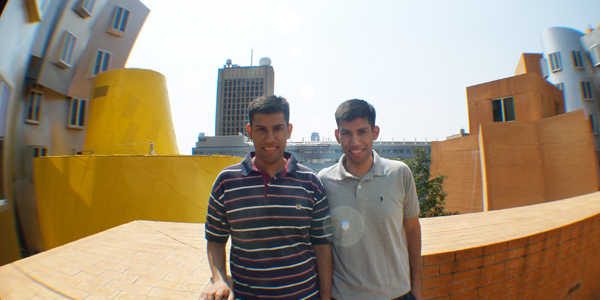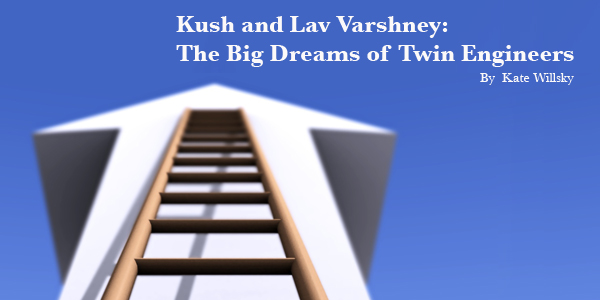Maybe the desire to be an engineer runs in the blood. Maybe, like the genomes that Kush Varshney studies with graphical models, it clings to DNA and lures in proteins, becoming a transcription binding site and securing its continued existence in future generations. The Varshney family pedigree offers a prodigious case example of this theory.
“Our grandfathers and our father were electrical engineering professors,” says Lav Varshney. He and his twin Kush are both LIDS students working on their PhD theses in engineering. This legacy actually goes back more than just two generations. Years after fully launching themselves into the world of engineering, Kush and Lav discovered, through vague family whispers and some help from the MIT archives, that their great-great grandfather, Ishwar Das Varshnei, studied chemical engineering at MIT in the early 20th century. He went on to more or less found the glass industry in India.
Whether passed through blood or chance, the curiosity, drive, and innovation that produce a successful engineer have coursed through these past hundred years, running strong as ever to and through Kush and Lav. While Kush was more naturally interested in math and physics, and Lav admits that he was “actually better at social studies,” both chose to pursue engineering degrees at Cornell University. The twins graduated in the spring of 2004 and suspended their studies for a few brief months of travel, including some time in India and at the Olympics in Athens. Then they were Boston bound, arriving at MIT by summer’s end, ready to dive into their graduate studies.
“I think for me the faculty was the main reason I came here,” says Lav. In Central New York, Kush says, people “don’t necessarily have big expectations before doing something but are happy when it turns out well,” while at MIT, people “are aggressive and have expectations of succeeding. They’re more goal-oriented.” This attitude is part of Boston itself, Kush muses. It’s a city where people “feel like they want to make it a big city,” and, by virtue of their desire, it becomes one.
In such an environment, big dreams and grand goals flourish, and pursuing them becomes not only possible but absolutely necessary. The variety of Kush and Lav’s projects over the past few years mirrors this drive. They have studied information theory and signal processing, radar imaging, graphical models, and data compression, and are working toward practical applications as diverse as finding trapped oil underground and mathematically modeling racism in the NBA.
For his Master’s thesis, Kush studied radar imaging, using synthetic aperture radar to develop technology that would allow airplanes to identify the irregular, distorted, light-reflecting objects far below.
Since then, “I’ve really shifted gears,” Kush says. His current work involves looking at graphical models to represent probability distributions. Studying random variables with some unidentified correlation, Kush attempts the formidable, somewhat paradoxical task of “figuring out the randomness.”
In a valiant effort to give form to this advanced, abstract mathematical concept, Kush supplies a plethora of examples, starting with the weather in Boston and Syracuse. “They’re probably correlated in some way, like the temperature,” he says. Knowing the temperature in Boston can give you a pretty decent estimate of the temperature in Syracuse—but then add in India, a location with a completely independent temperature variable. A graphical model of this situation, with each place a different node in a graph with the nodes for Syracuse and Boston connected to each other but unconnected to the node for India, allows one to tease out correlations and understand the randomness.
“Actually, it’s a little more complicated,” Kush concedes, and offers DNA in cells and a videotape of a football game as other examples. He also mentions the work of the Stochastic Systems Group, which with recent funding from Shell Oil uses seismic data to create graphical models that reveal underground pockets of trapped oil. What these cases all emphasize, it seems, is the importance of recognizing patterns within a larger whole. “It’s about using what you’ve learned to identify what you’re given,” says Kush.
Lav, for his Master’s thesis, looked at the human brain as “an information storage device” in an attempt to study the functioning of the human mind by maximizing information storage capacity, while also conserving resources, a challenge with potential applications for computers and databases (as well as human beings). Since completing his Master’s, he has been “playing around with various problems and they all seem to be related to graphs.” He’s interested in connections within networks, an idea that could apply to the Internet, genomes, and neurons in the brain, among much else. An example of the type of graphical connection he might find, Lav explains, is to take an image, segment it into pieces, and look at the way these pieces are attached.
Ultimately, he says, “the question I’ve been looking at here is whether there are source coding theorems for graphs.” This line of research looks to compress data, squeezing all of the information from an ensemble of graphs into a simplified code, one requiring fewer binary digits. Using probability and general knowledge, one is led, eventually, to universal compression theory, the idea behind zip files, which states that one need not know the information in something to compress that information. “Zip is actually considered one of the great successes of an application of information theory,” Kush interjects, underscoring the importance of this project.
Still, these forays into research are tentative PhD ideas, and neither Kush nor Lav has definitively chosen a topic. “The deadline’s pretty flexible,” Lav says. But, as he wisely adds, the earlier you get started, the earlier you can finish.
Meanwhile, LIDS provides an active and stimulating intellectual environment in which to develop these ideas and discover new ones. Indeed, one of the most valuable aspects of the lab has been its ability to introduce students to the overall research process, Kush says, allowing them to start off with a “small idea…and build upon it and see where it goes.”
The lab has also allowed both brothers to attend myriad conferences over the past few years, traveling to Florida, Utah, San Diego, and Lake Tahoe and hearing about current developments in the fields of biomedical imaging, data compression, and information theory. Lav calls these conferences “really, really tiring,” but emphasizes their ability to expose researchers to problems and questions they would not otherwise encounter. “You do learn a lot,” he says. “There are so many new ideas, and you get to talk to people and meet people.”
This commitment to bringing people and their ideas together applies to daily life, too, as with LIDS’ Student Socials, a practice that Kush considers one of the great aspects of the lab. “It’s a good way to just get everyone out,” he says.
Socials aside, the brothers both lead active and diverse lives beyond the confines of the laboratory. Traveling scores high as a recreational interest, with Geneva, Berlin, Brussels, and Paris receiving honorable mentions as some of the most memorable and enjoyable cities for the brothers.
While in Boston, (although there’s not a whole lot of time to relax, Lav admits), the brothers explore the city, attending sports games or social events with other graduate students. Relaxation, of course, also includes the simple joy of “just sitting back and watching TV,” says Kush.
Still, these respites are only momentary breaks in the action, commas within the constantly lengthening, infinitely complex, subordinate-clause-ridden run-on sentence that is electrical engineering. After all, it was the energy and dynamism of the field that attracted Kush and Lav in the first place.
As a newer discipline, electrical engineering seems, to Kush, “where all the action is.” It is a field in flux, the “liberal arts of engineering,” according to Lav. This latter quality directly appeals to Lav, who emphasizes the importance of applying math and science to human life. “You can do straight up information theory if you want to. The question then is, is it relevant to anything?” he asks, declaring that his engineering must be motivated by a concrete goal, however far-removed or indirect it might be. Electrical engineering, by virtue of its abstract nature, can be applied to many things, allowing a freedom within the field, particularly an ability to look at human-scale implications that could lead to social or policy changes.
The experimentation allowed in electrical engineering seems analogous to the freedom and lack of responsibility of a university student. Kush and Lav recognize the unique privilege afforded a student and relish the uninhibited intellectual environment and relatively unstructured lifestyle. “You don’t have to have a real job,” Lav says, smiling. “And we don’t want to grow up anyway!” But still, the pull of personal growth is as strong as that of technological progress. Kush notes that, despite all the upsides, he would not want to stay a student interminably. “You feel like you should be graduating at some point, and doing some other things,” he says. Given what Kush and Lav have done so far, and the long line of innovation and talent that preceded them, we can only imagine what these “other things”—the fresh ideas and exceptional projects—will be.




